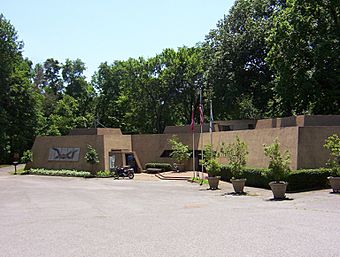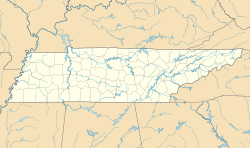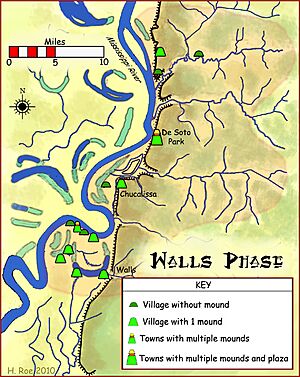Chucalissa facts for kids
|
Chucalissa Site
|
|

C.H. Nash Museum at Chucalissa (2009)
|
|
| Location | 1987 Indian Village Drive, Memphis, Tennessee |
|---|---|
| Area | 160 acres (65 ha) |
| NRHP reference No. | 73001830 |
Quick facts for kids Significant dates |
|
| Added to NRHP | May 7, 1973 |
| Designated NHL | April 19, 1994 |
The C.H. Nash Museum at Chucalissa is a special place in Memphis, Tennessee. It is built on an ancient Native American village site called Chucalissa. The name "Chucalissa" means "abandoned house" in the Chickasaw language.
This site is next to T. O. Fuller State Park. It is very important because it is one of the best-preserved ancient villages in the area. In 1994, Chucalissa was named a National Historic Landmark. This means it is a place of great historical value to the United States.
Contents
Discovering Chucalissa
Chucalissa was once a busy village built by people of the Mississippian culture. This culture lived in the southeastern United States a long time ago. The village was used, left empty, and then used again many times. This happened between the years 1000 and 1550 CE.
The village sits on a high piece of land overlooking the Mississippi River. People who lived here built large mounds and a central plaza. These mounds were often used for important buildings or ceremonies.
Life in the Ancient Village
Archaeologists have found many amazing things at Chucalissa. They found well-preserved remains of buildings and tools. They also found plant and animal remains. These discoveries help us understand how the people lived. We can learn about their homes, what they ate, and how they used the land.
Other groups of people lived nearby during the same time. These included the Parkin, Menard, and Nodena phases. They were all part of the larger Mississippian culture.
European Explorers Arrive
In the early 1540s, a Spanish explorer named Hernando de Soto traveled through this area. His group stopped at many villages along the Mississippi River. Some historians think that the villages de Soto saw were part of the "Walls phase," which Chucalissa belonged to.
However, there is no proof that de Soto's group actually visited Chucalissa itself. It is believed that the village was empty when he passed through.
The C.H. Nash Museum
The Chucalissa site was first discovered by accident. In 1938, workers from the Civilian Conservation Corps found Native American artifacts there. This led to archaeological digs starting soon after.
Since 1962, the University of Memphis has managed the C.H. Nash Museum at Chucalissa. The museum is named after its first director, C.H. Nash.
A Place to Learn and Explore
The museum and the village grounds are cared for by staff and students. They work to protect the site and teach visitors about its history. The museum has a large collection of artifacts. These items were found during 40 years of careful digging at the site.
When you visit, you can see a Mississippian mound complex. There is also a nature trail and an arboretum, which is like a tree garden. You can even try out hands-on archaeology in a special lab. The exhibits teach you about the history and daily lives of Native Americans in the southeastern United States.
See also




